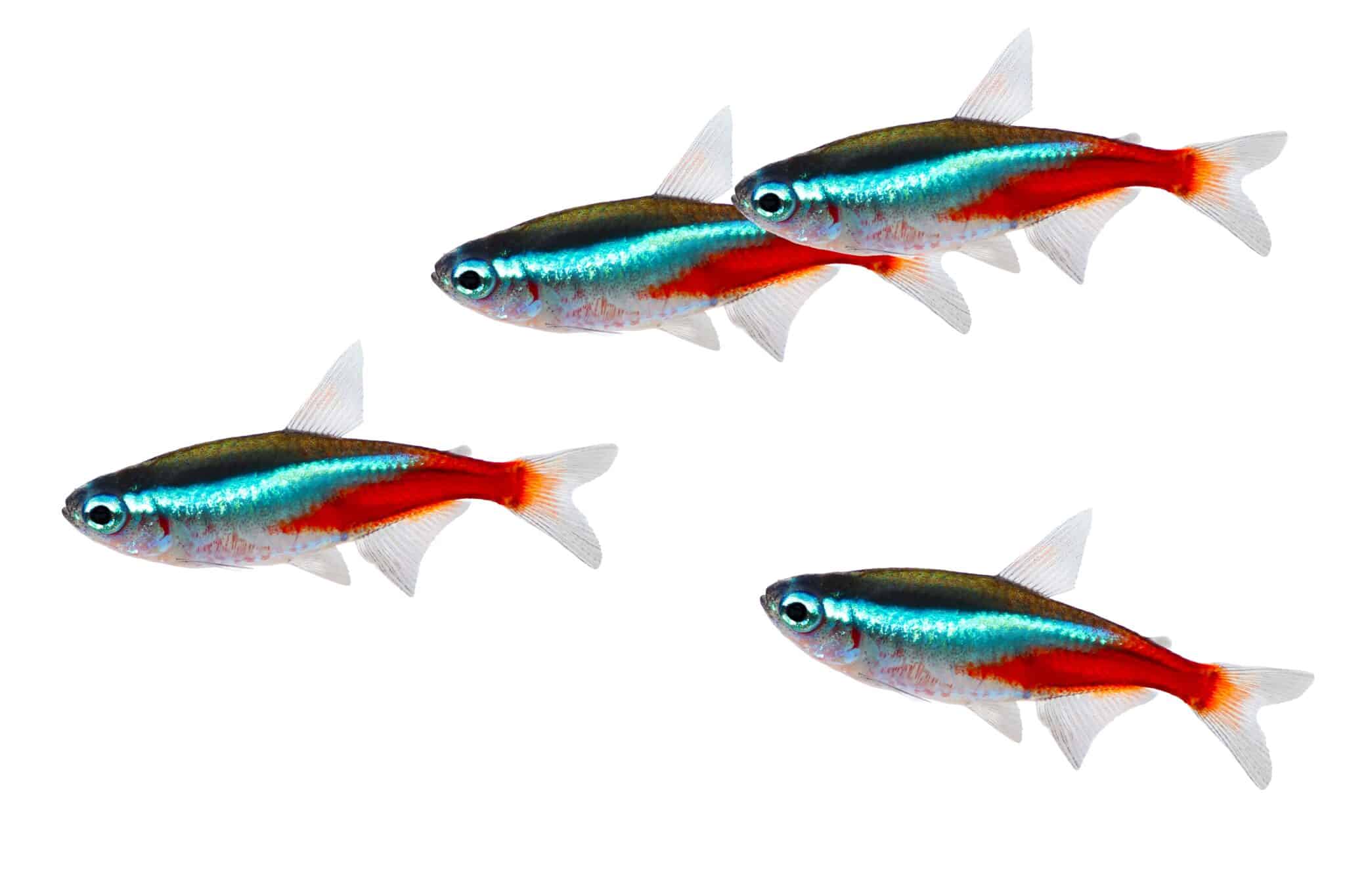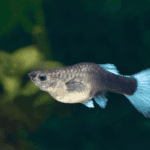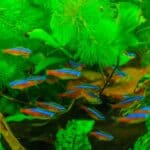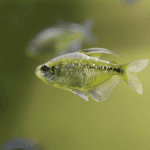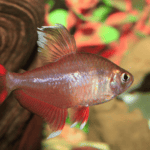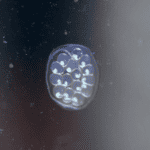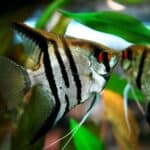Neon tetras are a popular choice for freshwater aquarists due to their vivid colors and peaceful nature. Recognizing a pregnant neon tetra involves understanding subtle changes in their behavior and appearance. Unlike many other fish, neon tetras are actually egg-layers and do not get pregnant in the traditional sense. When they are ready to breed, the females become plumper as their bodies fill with eggs, and this is often mistook for pregnancy. Knowing the signs of a neon tetra ready to spawn is the first step in providing the proper care.
Caring for neon tetras during this breeding phase requires adjustments to their environment and special attention to water quality. It’s crucial to provide an optimal setting for spawning and to maintain conditions that mimic their natural habitat. Gentle filtration, subdued lighting, and an abundance of fine-leaved plants can encourage the breeding process. After spawning, the parent tetras often eat their eggs or fry, so timely intervention is needed to protect the offspring.
Key Takeaways
- Spotting a breeding-ready female neon tetra involves looking for a notably rounder belly.
- Preparing a favorable breeding environment with controlled conditions is essential for neon tetra spawning.
- Protecting the eggs and fry post-spawning is crucial to increase survival rates.
Understanding Neon Tetra Biology

In our examination of neon tetras, recognizing the biological sex differences is critical. This information is essential for identifying and caring for pregnant neon tetras effectively.
Recognizing Sex Differences
When we look at male and female neon tetras, there are distinct characteristics that set them apart. Males typically have a brighter, more vivid coloration and a straighter blue line running along their bodies. On the other hand, females may present a slightly duller hue and their blue line often curves slightly when they are full of eggs.
Male Neon Tetras:
- More vibrant colors
- Straight blue line along the body
- Generally slimmer shape
Female Neon Tetras:
- Less pronounced coloration
- Curved blue line when gravid (pregnant)
- Fuller body, especially when viewed from above
Spotting these differences becomes easier with practice, and it is these subtle visual cues that enable us to differentiate between males and females in a neon tetra population. By understanding these sex characteristics, we are better equipped to provide proper care during the breeding process.
Setting the Stage for Breeding
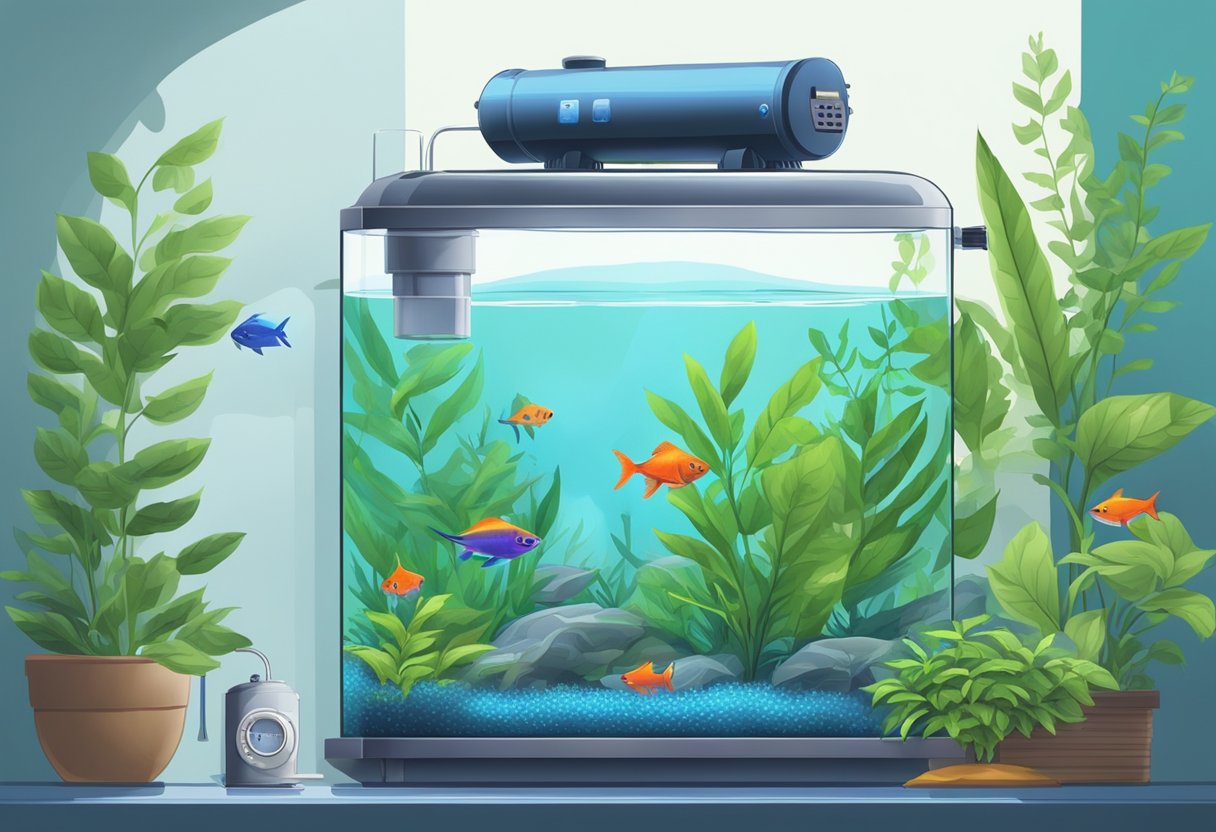
To successfully breed neon tetras, we need to provide them with an environment that closely mimics their natural habitat, focusing on water quality and stability while setting up conditions that encourage their mating behavior.
Creating a Conducive Breeding Environment
First, we ensure a separate breeding tank is ready, as this will allow us to monitor and control the environment closely. This tank should be about 5-10 gallons and have a dark substrate to mimic the dark riverbeds of their natural environment. Minimal lighting is preferred, mimicking the subdued lighting conditions of their habitat. We provide fine-leaved plants or a spawning mop to offer the fish places to lay their eggs.
Optimizing Water Conditions for Spawning
Maintaining stable water chemistry is crucial for breeding neon tetras. Ideal water conditions include:
- Water temperature: 72-76°F (22-24°C)
- pH level: 5.0-7.0, slightly acidic
We frequently test the water to ensure these parameters remain consistent, as fluctuations in temperature or pH can disrupt the breeding process and potentially harm the fish.
Introducing Courtship and Breeding Behaviors
To encourage courtship, we mimic the rainy season of the tetras’ natural environment by performing small, frequent water changes, which can stimulate spawning. We feed the breeding neon tetras a varied diet of high-quality live or frozen foods to ensure they are in the best condition for breeding. It’s critical to closely observe the fish for signs of pairing and egg-laying behavior, which typically occurs in the early morning.
Caring for Pregnant Neon Tetras
When we manage pregnant neon tetras, it is crucial to correctly identify them and provide the necessary nutrition and environmental conditions to support their health and the development of their offspring.
Identifying Pregnant Neon Tetras
We can determine if a neon tetra is pregnant by observing several physical changes. A noticeable sign is a swollen belly that appears fuller as the eggs develop. Additionally, we may see a gravid spot, a darkened area near the belly, which indicates the presence of eggs. These signs help us differentiate pregnant neon tetras from those that are not.
Maintaining Proper Nutrition and Environment
Nutrition:
To ensure proper care, pregnant neon tetras require a diet rich in vitamins and nutrients. We should feed them high-quality flakes or pellets, supplemented with live or frozen foods such as brine shrimp or bloodworms. This diverse diet supports the increased nutritional needs during pregnancy.
Environment:
Maintaining a stable and stress-free environment is essential for the well-being of pregnant neon tetras. The following table outlines the key environmental parameters we must uphold:
| Parameter | Ideal Condition |
|---|---|
| Water Temperature | 72-76°F (22-24°C) |
| pH Level | 5.0-7.0 |
| Water Hardness | 1-2 dGH (very soft water) |
| Lighting | Moderate, with periods of darkness to mimic natural light cycles |
It is beneficial to include live plants in the tank, as they provide hiding spots, reduce stress, and help maintain water quality. Pregnant neon tetras thrive in a well-planted aquarium that replicates their natural habitat.
The Spawning Process
The spawning process in neon tetras encompasses a series of well-coordinated steps, starting with courtship behaviour and culminating in the laying and fertilization of eggs.
From Courtship to Egg Laying
During courtship, we often observe a dance-like sequence where the male and female exhibit specific behaviors. The breeding pair displays a vibrant coloration, with males intensifying their blue stripes to attract females. Once a pair is established, they select a spawning site, which typically includes plants or a flat surface. The female lays her eggs as the male follows closely to fertilize them. This step is critical — ensuring the fertilization of eggs ensures the continuation of the species.
Key aspects of the egg-laying phase include:
- Courtship behavior: Vibrant coloration, specific movement patterns.
- Breeding area: A quiet place with plants or a suitable flat surface.
- Egg laying: The female releases the eggs, usually in small batches.
- Fertilization: The male releases milt over the eggs to fertilize them.
Egg Care and Hatching
After the eggs are laid and fertilized, they require optimal conditions to develop and eventually hatch. The eggs are adhesive and attach to the substrate or plants within the spawning site. Egg care involves maintaining water quality and temperature to support the development of fertilized eggs.
Important measures include:
- Temperature regulation: Keeping water temperatures around 77°F (25°C).
- Clean environment: Frequent partial water changes to reduce the buildup of harmful substances.
- Monitoring: Observing eggs for signs of fungus or other abnormalities.
Eggs typically hatch within 24 hours, depending on the temperature. The fry is born without a yolk sac and requires an external food source almost immediately. Our focus during this time is to provide food suitable for newborn fry, such as infusoria or liquid fry food, and continue ensuring pristine water conditions for their survival.
Raising Neon Tetra Fry
Upon successful spawning, we must shift our focus to provide the best care for neon tetra fry. These initial stages are crucial for their survival and development.
Initial Fry Care
At birth, neon tetra fry are barely visible and will not eat until they have absorbed their yolk sac, typically after 24 hours. Once they start feeding, infusoria—or microscopic organisms found in water—is an ideal first food due to its small size. After the first few days, we can gradually introduce rotifers and liquid fry food, which are rich in nutrients and small enough for the fry to consume.
Daily water changes of 10-25% are essential to maintain clean water and reduce the risk of disease. However, we must ensure the new water is the same temperature and has similar chemistry to the water in the fry tank to avoid shocking the delicate fry.
Fry Feeding Schedule
| Days After Hatching | Food Source |
|---|---|
| 1-3 | Infusoria |
| 4-7 | Infusoria, Rotifers |
| 7+ | Liquid Fry Food, Rotifers |
Ensuring Fry Survival Skills
Achieving self-sufficiency is a milestone in the life of a neon tetra fry. We introduce live foods, such as brine shrimp nauplii, at about four weeks to enhance their hunting skills. This practice encourages natural behaviors and contributes to their growth.
Ensuring the right breeding conditions remains crucial even after hatching. We provide scattered rocks and plants for the fry to hide in and practice their survival skills, simulating their natural habitat.
Teaching the fry these skills early on sets the foundation for a robust adulthood, equipping them with the necessary instincts to thrive in both breeding tanks and aquarium environments.
Frequently Asked Questions
In this section, we cover the most common inquiries about identifying and caring for pregnant neon tetras to ensure the well-being of both the expectant fish and their offspring.
What are the signs of a pregnant neon tetra?
Neon tetras are not livebearers, which means they don’t get pregnant in a traditional sense but will carry eggs before laying them. Signs that a neon tetra is carrying eggs include a slightly swollen belly and a more rounded overall appearance. The female may also display a more pronounced blue stripe.
How can one care for neon tetra eggs to ensure successful hatching?
It’s critical to remove the eggs to a separate breeding tank to avoid predation from adult tetras. The breeding tank should have soft, acidic water and be kept at a stable temperature, slightly warmer than the main tank. An anti-fungal agent may also be added to prevent fungus from destroying the eggs.
How frequently do neon tetras lay eggs?
A female neon tetra can lay eggs approximately every two weeks under optimal conditions. Regular water changes, a balanced diet, and the right tank conditions can promote more frequent spawning cycles.
What are the optimal tank conditions for a pregnant neon tetra?
A pregnant neon tetra requires clean, warm water ranging from 72 to 76°F (22 to 24°C) with a slightly acidic pH of about 6.0 to 7.0. Soft water with a low mineral content is ideal. Dim lighting and plenty of hiding places with plants or décor can also reduce stress.
How long does it take for neon tetra eggs to hatch?
Neon tetra eggs typically hatch in about 24 hours, depending on the temperature of the water. Slightly warmer water can speed up the process, while cooler temperatures may delay hatching.
What should be done to support neon tetra fry once they have hatched?
After hatching, neon tetra fry should be fed a diet of micro foods, such as infusoria or liquid fry food, until they are large enough to eat freshly hatched brine shrimp. The breeding tank should be maintained with pristine water conditions, performing gentle water changes to reduce the risk of disease.
